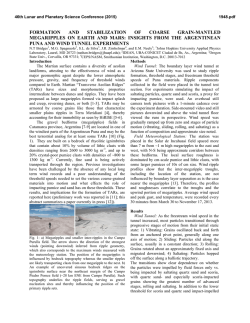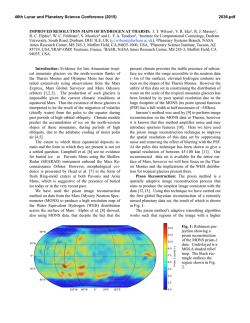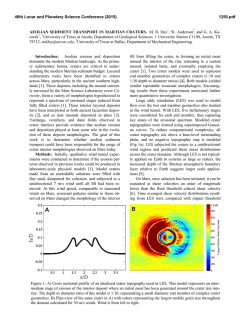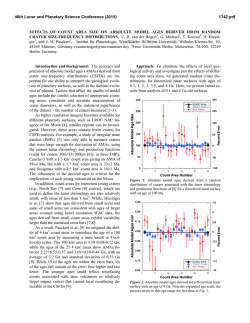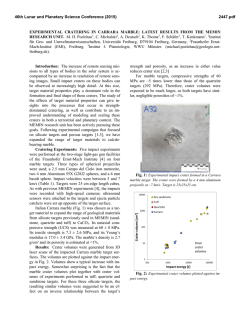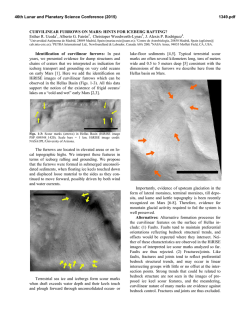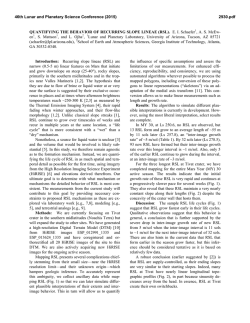
Geospatial Classification of Transverse Aeolian Ridges on Mars
46th Lunar and Planetary Science Conference (2015) 1137.pdf GEOSPATIAL CLASSIFICATION OF TRANSVERSE AEOLIAN RIDGES ON MARS. E. K. Ebinger1 and J. R. Zimbelman2, 1Brown University Department of Geological Sciences, Providence, RI 20912, [email protected], 2CEPS/NASM MRC 315, Smithsonian Institution, Washington, DC 20013-7012. Introduction: Small aeolian bedforms, known as Transverse Aeolian Ridges (TARs) are widespread on the martain surface. It is unknown whether the features are large ripples or small dunes [1,2], but insight can be gained from their distribution on Mars. We have geospatially mapped TARs within two pole-to-pole swaths and hypothesize that TARs are controlled by local geology, elevation, and latitude. Analysis of HiRISE images at two longitudes indicates that TARs are not homogenously distributed on Mars. Instead, they are concentrated in low latitudes with almost none poleward of 45°N and 50°S. In addition, TARs are more common in topographic lows. They are found in craters, troughs, and valleys – especially in Valles Marineris and Kasei Valles – but their presence is diminished in the Tharsis region. Methodology: Two pole-to-pole swaths – 290°E300°E and 240°E-250°E – were chosen for examination because they contain some of the highest and lowest elevations on Mars. Nearly 1000 HiRISE images were examined in HiView and the local TAR coverage per image was estimated and recorded. TARs were identified and classified using the classification scheme of Balme et al. (2008), which describes TARs by morphology (simple, networked, forked, sinuous, barchan-like) and topographical influence (independent, influenced, controlled, confined). All examined images were then located according to their center latitude and longitude (Figure 1). Findings: The mean areal TAR coverage for the 290°E-300°E swath is 8% (4% in the Northern Hemisphere and 12% in the Southern Hemisphere) and 42% of the surveyed images contained at least 5% coverage by TARs, while 25% contained no TARs at all. The mean areal TAR coverage for the 240°E250°E swath is 1% (0.6% in the Northern Hemisphere and 1.8% in the Southern Hemisphere). Of the surveyed images, 6% contained at least 5% coverage by TARs, while 70% contained no TARs at all. Thus, the mean areal TAR coverage for both swaths is 5%, and no TARs were found poleward of 64N nor 59S. Based on these data, we propose that TARs are controlled by local geology, which is influenced by elevation and latitude. Local geology. The composition and formation of TARs is still unclear, mostly due to lack of in situ measurements. However, potential terrestrial analogs such as small transverse dunes and large granule ripples give insight into the structure of TARs [1, 3]. We hypothesize that TARs consist of coarse-grained sediment that traps sand and silt, similar to the gravelmantled megaripples of the Argentinian Puna [4]. The sediment source is likely locally derived [1,2] from weathering, wind abrasion, and mass wasting. Thus, regions with steep slopes and local exposures of layered bedrock have more extensive TAR fields due to increased local sediment supply. This sediment is trapped in topographic lows such as craters, valleys, channels, and troughs. It is in these controlled or confined locations where TARs are most commonly found (Figure 2a, 2b). In addition, regions with less sand are assumed to have fewer TARs, which is evident when looking at the dusty surface of Pavonis Mons. Under low local pressures, dust that settles from the martian atmosphere is trapped on the Tharsis Montes, accumulating thick layers of dust [5]. The timeframe from which TARs form is unclear, but if TARs formed in Tharsis long ago they may have since been buried in dust. And if TARs are currently active, there may not be enough sand at high altitudes to sustain TARs – the low pressures are unfavorable for saltation and creep of the coarse-grained material assumed to comprise TARs [5] (Figure 2c). Figure 1: Distribution of HiRISE images surveyed with percent TAR coverage indicated by size of circle (larger = greater coverage) with MOLA background and swaths outlined in white. 46th Lunar and Planetary Science Conference (2015) Elevation. Therefore, one dominant control on the formation of TARs is local elevation. TARs were not found on steep slopes or mountains but instead almost exclusively within topographic lows. Elevation is more than just a local control, however. As seen from the distribution of TARs (Figure 1) there is a greater abundance at lower elevations across the planet. TAR fields within Tharsis are sparce and mostly isolated, while TARs are plentiful within Valles Marineris and Kasei Valles (Figure 3). This disjunction is likely a result of differences in local geology and air pressure – the lows of Valles Marineris and Kasei Valles are favorable for accumulation of sediment that sources TARs, while the high dusty surfaces of Tharsis do not favor the formation of TARs. Latitude. Another control on TAR formation is latitude. TARs are not ubiquitous, and are actually heavily concentrated at low latitudes. Excluding a few outliers, TAR concentrations are restricted to between 45N and 50S. TARs are almost absent within the Northern Plains, and despite their presence within many craters there appear to be almost none poleward of 50S – however, it should be noted that TARs are 3x more prevalent in the Southern Hemisphere than in the North, likely due to the greater number of large impact craters. The lack of TARs at high latitudes is possibly related to the presence of mantling terrain, which could be preventing aeolian transportation of the materials that comprise TARs and/or burying TARs (Figure 2d) [2]. Thus, although the elevation of the Northern Plains is lower than most of the martian terrain, it is too high in latitude to favor TARs. 1137.pdf Future studies should examine pole-to-pole swaths in other regions of Mars to test these conclusions, notbaly the Nilosyrtis Highlands. In addition, sampling of TAR-like features by the Curiosity rover or future rover expeditions are needed to further understand the composition and formation of TARs. References: [1] Balme M.R. et al. (2008) Geomorphology 101, 703-720. [2] Berman D.C. et al. (2011) Icarus 213, 116-130. [3] Zimbelman J.R. (2010) Geomorphology 121, 22-29. [4] de Silva S.L. et al. (2013) GSA Bulletin 125, 19121929. [5] Bridges N.T. et al. (2010) Icarus 205, 165-182. a 100 m ESP_028305_1210 ESP_014391_2045 c d 50 m ESP_016846_1710 100 m ESP_035265_1675 Figure 2: TARs form mostly in depressions near steep slopes and layered bedrock, as seen in a) Kasei Valles and b) Coprates Chasma. However, c) on Tharsis ripples form within craters rather than TARs, and d) in the Southern Highlands mantled terrain and ground ice hinder TAR formation. b a % TAR coverage: 0-4 = blue 5-25 = green 26-50 = yellow 51-100 = red b 50 m % TAR coverage: 0-4 = blue 5-25 = green 26-50 = yellow 51-100 = red Figure 3: Distribution of HiRISE images included in study from a portion of a)Valles Marineris and b)Pavonis Mons, with backgrounds from Google Mars. Percent areal TAR coverage designated by color of image outline rectangle.
© Copyright 2025
